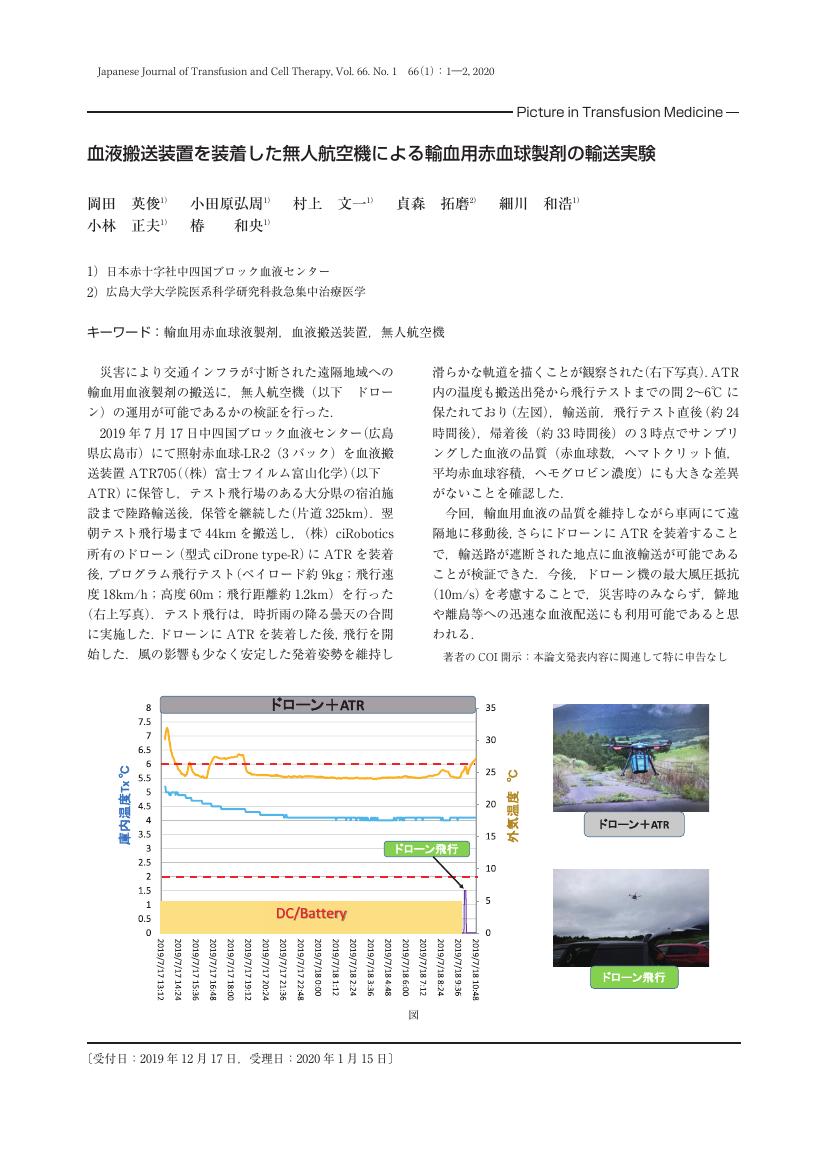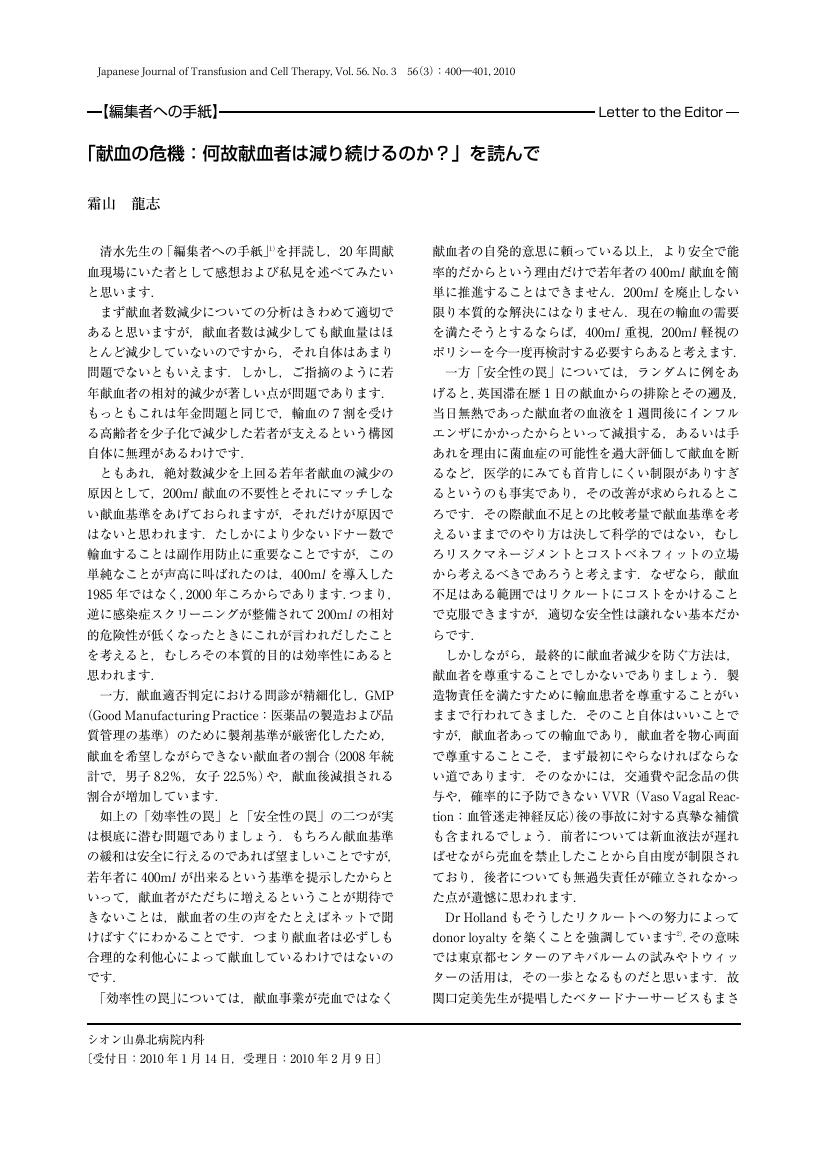58 0 0 0 OA 新生児・乳幼児におけるABO血液型の一致率の解析
- 著者
- 小林 美佳 岸野 光司 秋山 友子 進藤 聖子 大槻 郁子 菅野 直子 藤原 慎一郎 山本 千裕 室井 一男
- 出版者
- 一般社団法人 日本輸血・細胞治療学会
- 雑誌
- 日本輸血細胞治療学会誌 (ISSN:18813011)
- 巻号頁・発行日
- vol.66, no.4, pp.613-618, 2020-08-25 (Released:2020-09-18)
- 参考文献数
- 11
- 被引用文献数
- 1 1
生後4カ月未満児のABO血液型検査は,母由来の移行抗体や抗A抗Bの産生が不十分であることから,オモテ検査のみの判定でよいと厚生労働省の「輸血療法の実施に関する指針」に明記されている.しかし,生後4カ月以降のウラ検査については,明確にされていない.今回,当院でABO血液型検査を実施した2010年1月から2017年4月までの約7年間における3歳未満の乳幼児,延べ1,068例のABO血液型検査について解析した.生後1カ月未満児と生後1カ月以上4カ月未満児のABO血液型オモテ検査とウラ検査の一致率(一致率)を比較すると有意差は認められなかった(P=0.638).さらに生後4カ月以上1歳未満の乳児を2カ月毎に一致率を比較検討した.その結果,月齢を重ねるに従い一致率も上昇した.また生後4カ月未満児の一致率(56.6%)と生後4カ月以上1歳未満児の一致率(76.5%)の比較では,有意差(P<0.001)が認められた.さらに,生後1歳以上では約90%の一致率が認められ,以上の結果より乳幼児のオモテ・ウラ検査を用いたABO血液型を確定する時期は,生後1歳以上が適切と考えられる.
29 0 0 0 OA 高校生献血の契機に関する意識調査(第2報)―高校生にとって効果的な献血推進方法とは―
23 0 0 0 OA 高校生の献血に向けて効果的な献血推進活動とは:高校生を対象とした献血に関する意識調査(第3報)
16 0 0 0 OA 輸血用血液の細菌汚染と敗血症
- 著者
- 高橋 雅彦 名雲 英人
- 出版者
- 一般社団法人 日本輸血・細胞治療学会
- 雑誌
- 日本輸血細胞治療学会誌 (ISSN:18813011)
- 巻号頁・発行日
- vol.54, no.3, pp.359-371, 2008 (Released:2009-01-30)
- 参考文献数
- 119
- 被引用文献数
- 5 5
13 0 0 0 OA 我が国の献血の現状と課題
- 著者
- 松坂 俊光
- 出版者
- 一般社団法人 日本輸血・細胞治療学会
- 雑誌
- 日本輸血細胞治療学会誌 (ISSN:18813011)
- 巻号頁・発行日
- vol.59, no.5, pp.725-732, 2013 (Released:2013-10-24)
- 参考文献数
- 31
- 被引用文献数
- 2 6
12 0 0 0 OA 輸血用血液製剤の細菌汚染の現状と対策
- 著者
- 名雲 英人 佐竹 正博
- 出版者
- 一般社団法人 日本輸血・細胞治療学会
- 雑誌
- 日本輸血細胞治療学会誌 (ISSN:18813011)
- 巻号頁・発行日
- vol.60, no.1, pp.3-11, 2014-02-28 (Released:2014-03-20)
- 参考文献数
- 59
- 被引用文献数
- 3 4
- 著者
- 大城 正巳 廣末 雅幸 平安山 睦美 上間 昇 久田 友治
- 出版者
- 一般社団法人 日本輸血・細胞治療学会
- 雑誌
- 日本輸血細胞治療学会誌 (ISSN:18813011)
- 巻号頁・発行日
- vol.65, no.4, pp.759-765, 2019-08-25 (Released:2019-09-19)
- 参考文献数
- 15
人口当たりの年齢別輸血頻度と主な診療科の輸血単位数の変化について詳細を明らかにすることを目的として,輸血用血液製剤の使用状況調査を行った.輸血用血液製剤供給上位19施設から2012,2017年度の輸血情報(輸血年月日,製剤名,製造番号,診療科,患者識別番号(匿名化),輸血時年齢)を電子データで収集した.2017年度の輸血頻度の最頻値年齢は,赤血球製剤が89歳,血漿製剤が78歳,血小板製剤が82歳であった.年度間で50歳以上の輸血頻度が,有意に減少していた.その増減率中央値は赤血球製剤が-21.1%,血漿製剤が-23.1%,血小板製剤が-28.0%であった.多くの診療科で使用量は減少していたが,救急集中治療科は全ての製剤が増加していた.赤血球製剤の輸血単位数は,68,352Uから64,200Uに減少していたが,患者実人数は,8,377名から8,882名に増加していた.その内訳は,2単位輸血の患者実人数は増加し,4~8単位は減少していた.その傾向は,内科一般,外科一般,心臓血管外科,整形外科で強かった.これらの状況から,高齢化による患者数の増加はあるものの,患者一人当たりの輸血量は抑制されていることが確認できた.
7 0 0 0 OA 北海道函館赤十字血液センターの製剤部門集約における血小板製剤緊急使用への影響
- 著者
- 山本 哲 山本 定光 久保 武美 本間 哲夫 橋本 浩司 鈴木 一彦 池田 久實 竹内 次雄
- 出版者
- 一般社団法人 日本輸血・細胞治療学会
- 雑誌
- 日本輸血細胞治療学会誌 (ISSN:18813011)
- 巻号頁・発行日
- vol.57, no.3, pp.173-177, 2011 (Released:2011-07-27)
- 参考文献数
- 6
北海道函館赤十字血液センター(以下函館センター)の製剤部門は2006年に北海道赤十字血液センター(以下札幌センター)に集約され,管内供給は北海道ブロックの需給コントロールによって管理されることとなった.製剤部門の集約は,在庫量の少ない血小板製剤に影響が現れやすいと考えられたので,同製剤の緊急需要(当日受注)に対する供給実態について,受注から配送に至る経過に焦点をあて回顧的に調査した.当日受注で,在庫分に由来すると思われる配送所要時間が2時間未満の血小板製剤の割合は集約直後の2006年度で減少したものの,在庫見直し後の2009年度は2005年度並みに回復した.在庫分がなく札幌からの需給調整に由来すると思われる所要時間6時間以上の割合は2005年,2006年に比べ,2009年度では半減した.時間外発注で1時間以内に配送した割合も在庫見直し後の2009年度に有意に増加し88.5%に達した.製剤部門の存在は,血小板製剤の緊急需要に対し,一時的な在庫量の増加をもたらすものの安定供給の主要な要因とはならず,適正な在庫管理が最も重要な要因であることがわかった.血小板の緊急需要に対しては,通常の需要量を基礎にして在庫量を設定すること,需要量の変化に応じてそれを見なおすことにより対応が可能であった.供給規模が小さく,在庫管理の難しい地方血液センターでは,血小板製剤の広域の需給調整を活発にすることで経済効率を保ちつつ医療機関の需要に応えるべきと考える.
5 0 0 0 OA 献血における循環血液量の減少を伴わない血管迷走神経反応
- 著者
- 山本 哲 荒木 あゆみ 算用子 裕美 小澤 敏史 金井 ひろみ 池田 久實 高本 滋
- 出版者
- 一般社団法人 日本輸血・細胞治療学会
- 雑誌
- 日本輸血細胞治療学会誌 (ISSN:18813011)
- 巻号頁・発行日
- vol.63, no.2, pp.105-111, 2017-04-20 (Released:2017-05-11)
- 参考文献数
- 15
採血副作用における血管迷走神経反応(VVR)は,その低減化に向けて様々な防止策が講じられている.VVRの発症機転はよく解明されていないが,不安や痛み等の精神的な要因,循環血液量の減少による生理学的要因などが推定されている.今回我々は循環血液量の減少を伴わない採血前検査で発生するVVRに焦点をあて,精神的な要因により発症するVVRの特徴について検討した.本採血前のVVRを2群(検査前群と検査後群)に分類し,本採血以降のVVRと比較検討した.その結果,本採血前のVVRでは,体格が小柄で比較的やせ気味の10代の若年男性が多く含まれ,女性では3人に1人は体重50kg未満という特徴が見られた.これらのVVRでは重症例も多くあり軽視すべきではなく,採血基準を体重50kg以上に制限することで女性のVVRは減少すると推定される.
4 0 0 0 OA 日本人は一生の間に何回輸血を受けるのか?―神奈川県6病院の分析からの推計―
- 著者
- 吉場 史朗 加藤 俊一 大谷 慎一 小原 邦義 前田 清子 南 睦彦 寺内 純一 渡会 義弘 金森 平和 稲葉 頌一 絹川 直子
- 出版者
- 一般社団法人 日本輸血・細胞治療学会
- 雑誌
- 日本輸血細胞治療学会誌 (ISSN:18813011)
- 巻号頁・発行日
- vol.55, no.1, pp.48-57, 2009 (Released:2009-06-30)
- 参考文献数
- 6
- 被引用文献数
- 1 1
目的: 人間が一生の間にどの程度,輸血を受けるのかを知ることは,献血の際に,ボランティア·ドナーに説明するための必要なデータの一つである. 方法: 輸血回数を求めるに当たって,1.年齢別·性別人口,2.供給された献血本数,3.輸血を受けた患者の性別と年齢,を2つの県で集めた.第一は2002年の福岡県で,もう一つは2005年の神奈川県であった.各年齢の輸血回数の計算は,[Page=nage/Nage×T/t]の式で求めた.{Page:nage:各年齢の輸血患者実数,各年齢(Nage)ごとの輸血回数,T: 一年間に供給された血液本数,t: 病院で輸注された血液本数} 結果: 1)福岡県の2002年の全人口は,5,034,311名であった(男性2,391,829; 女性2,642,482).地域の赤十字血液センターは福岡県で輸血されるすべての血液をカバーしていた.2002年の血液供給本数は226,533本であった.一つの大学病院で輸血された患者数は,1,190名(男性646,女性544)であった.これらの患者に使用された血液は13,298本(男性7,210,女性6,088)であった.2)神奈川県の2005年の人口は,8,748,731名であった(男性4,420,831; 女性4,327,900).地域の赤十字血液センターは福岡県と同様,県内使用血液のすべてをカバーしていた.2005年の供給本数は297,592本であった.5つの大学病院と1つのがん専門病院で輸血を受けた患者の総数は3,744名(男性1,673,女性2,071)であった.これらの患者に使用された血液は57,405本(男性31,760,女性25,645)であった.男性の寿命を79歳とすれば,福岡県で0.420回,神奈川県では0.297回輸血を受けていた.女性の平均寿命を87歳とすれば,福岡県では0.344回,神奈川県では0.275回輸血を受けていた. 結論: 我々のデータから,日本人は一生の間に男性は1/3,女性は1/4が輸血を受けると考えられた.さらに,輸血の可能性は80歳以上で男性,女性ともに急増していた.
4 0 0 0 OA 血縁者間の輸血によって輸血後移植片対宿主病を起こすリスクについて
- 著者
- 安田 広康 野口 まゆみ 遠山 ゆり子 大戸 斉 阿部 力哉
- 出版者
- 一般社団法人 日本輸血・細胞治療学会
- 雑誌
- 日本輸血学会雑誌 (ISSN:05461448)
- 巻号頁・発行日
- vol.38, no.5, pp.596-600, 1992-11-15 (Released:2010-03-12)
- 参考文献数
- 21
Transfusion-associated graft-versus-host disease (TA-GVHD) was described as occurring after nonirradiated blood tranfusion not only in immunosuppressed but also in immunocompetent recipients who share one HLA haplotype with HLA-homozygous blood donors.From the distribution of 1% or more frequencies of HLA-A, -B, -C, -DR, -DQ haplotypes obtained at the 11th International Histocompatibility Workshop (1991), using the fomulae of Kanter, we tried to calculate the potential risk of TA-GVHD as a result of directed donations from relatives in the Japanese and other ethnic groups.The Japanese have the greatest risk of TA-GVHD than any other populations because are more homogeneous in HLA and have a common haplotype: A24-CBL-Bw52-DRw15-DQw1 (7.5%).Of noteworthing, the risk of transfusion of HLA-homozygotes to heterozygotes among 1st-degree relatives in the Japanese was 4.7-folds compared with that of transfusion in the U. S. A. population. And, the risk of TA-GVHD among the Japanese unrelated was near to that of transufusion among the French first degree relatives.Therefore, we recommend that donations of blood components from recipient's relatives should be irradiated essentially, and as possible even from unrelated donors in the Japanese population.
4 0 0 0 OA 高校生の献血意識に関する調査
- 著者
- 竹下 明裕 古牧 宏啓 浅井 隆善 梶原 道子 岩尾 憲明 室井 一男
- 出版者
- 一般社団法人 日本輸血・細胞治療学会
- 雑誌
- 日本輸血細胞治療学会誌 (ISSN:18813011)
- 巻号頁・発行日
- vol.62, no.6, pp.711-717, 2016-12-20 (Released:2017-01-12)
- 参考文献数
- 17
- 被引用文献数
- 1
近年,若年者の献血人口の減少が問題になっている.将来の献血を担う,高校生の献血に対する意識調査を行うことは献血の将来を考えていく上で重要である.アンケート方式による50項目の意識調査を行い,献血に関する高校生への広報や教育の現状と高校生の意識を調査した.調査は連結不可能の疫学調査として行い,35校中30校から協力が得られ,調査対象16,333人のうち15,521人(95.0%)より回答を得た.男性49.3%,女性は49.8%であった.献血を経験した高校生は1,198人(7.7%)で,未経験者は88.6%であった.疲労感や睡眠不足,ダイエット等は採血の際に注意すべき生活習慣である.献血可能年齢と体重,献血場所,献血に関わるリスク,血液の海外依存度等の献血に関する知識は不十分であった.献血への関心度は献血経験のある高校生で高く,初回献血の重要性が示唆された.高校への出張献血や献血に関する授業は献血を推進していく上で有用である.しかし献血に関する教育手法と普及活動にはさらに工夫が必要であると思われる.
3 0 0 0 OA エホバの証人に対する麻酔 術中希釈式自己血輸血の応用
- 著者
- 林 正則
- 出版者
- 一般社団法人 日本輸血・細胞治療学会
- 雑誌
- 日本輸血学会雑誌 (ISSN:05461448)
- 巻号頁・発行日
- vol.41, no.3, pp.300-303, 1995 (Released:2010-03-12)
- 参考文献数
- 15
- 被引用文献数
- 1
3 0 0 0 OA 頻回成分献血者の貯蔵鉄量
- 著者
- 内田 立身 西村 拓史 瀧本 宏美 佐藤 美津子 西尾 由美子 福家 洋子 野崎 正範
- 出版者
- 一般社団法人 日本輸血・細胞治療学会
- 雑誌
- 日本輸血学会雑誌 (ISSN:05461448)
- 巻号頁・発行日
- vol.44, no.1, pp.33-34, 1998-02-01 (Released:2010-03-12)
- 参考文献数
- 6
We evaluated the effect of repeated apheresis on storage iron status in 82 males and 138 females. Storage iron was calculated according to the formula proposed by the National Health and Nutrition Examination Survey (NHANES) as previously described. Calculated storage iron after repeated apheresis was 362±282mg in male donors and 128±176mg in females. These values were significantly lower than those in normal subjects and 400-ml repeated whole blood donors. A total of 12.2% of males and 45.7% of females were in negative iron balance before donation. The high prevalence of storage iron deficiencfy may be due to residual blood in the circuit or other factors.
3 0 0 0 OA 血液搬送装置を装着した無人航空機による輸血用赤血球製剤の輸送実験
- 著者
- 岡田 英俊 小田原 弘周 村上 文一 貞森 拓磨 細川 和浩 小林 正夫 椿 和央
- 出版者
- 一般社団法人 日本輸血・細胞治療学会
- 雑誌
- 日本輸血細胞治療学会誌 (ISSN:18813011)
- 巻号頁・発行日
- vol.66, no.1, pp.1-2, 2020-02-25 (Released:2020-03-13)
- 著者
- 中島 尚登 星 順隆 浅井 治 山本 純子 竹内 直子 神谷 昌弓 加藤 敦子 長谷川 智子 山崎 恵美 中山 一
- 出版者
- 一般社団法人 日本輸血・細胞治療学会
- 雑誌
- 日本輸血学会雑誌 (ISSN:05461448)
- 巻号頁・発行日
- vol.37, no.6, pp.795-802, 1991-12-25 (Released:2010-03-12)
- 参考文献数
- 18
A new red cell preservation solution is described in which the red cells may be stored for 42 and 49 days. An in vivo and vitro study of 42 and 49 days stored red cells with saline, adenine, glucose, mannitol (SAGM) preservation solution (OPTISOL, Terumo Corporation) was conducted using 20 healthy volunteers to document in vivo efficacy and analyze the validity of the 51Cr technique. Standard in vitro parameters of OPTISOL red cell concentrates were well preserved with low levels of hemolysis and high levels of red cell ATP which is compatible with their survival after 42 and 49 days storage. Osmotic pressure at hemolysis ending point of 42 and 49 days stored red cells did not change, while osmotic pressure at hemolysis starting point increased on 49 days. The red cell viscosity increased and scanning electron-microscopic studies showed that the majority of them became echinocyte and spherocyte on 49 days. In vivo autologous post-transfusion recovery was measured by using a 51Cr-labeled red cells. After 42 days of storage, post-transfusion 24-hour recovery averaged 82.3±8.4% and 48-hour recovery was 79.1±9.1%, and after 49 days, 24-hour recovery was 75.9±3.6%, but 48-hour recovery, which averaged 69.9±5.2%, was significantly lower.The present study reports in vivo and in vitro evaluation of a new red cell storage medium which allows high levels of post-transfusion recovery and permits without significant hemolysis. The results suggested that 42 days if a more suitable shelf life than 49 days.
3 0 0 0 OA X線照射が血液製剤中の赤血球に及ぼす影響
- 著者
- 福森 泰雄 田中 成憲 杉本 昭子 大軒 子郎 山口 英夫
- 出版者
- 一般社団法人 日本輸血・細胞治療学会
- 雑誌
- 日本輸血学会雑誌 (ISSN:05461448)
- 巻号頁・発行日
- vol.36, no.5, pp.580-586, 1990-10-30 (Released:2010-03-12)
- 参考文献数
- 13
Irradiation with X-ray to blood products is a standard practice recommended for prevention of post-transfusion graft versus host disease in patients. In order to seek the optimal condition of irradiation to minimize the lesion of red blood cell (RBC) with complete inactivation of lymphocytes, we studied the effects of irradiation with X-ray on the quality of RBC in whole blood (WB) and concentrated red blood cells (CRC) in the range of 5 to 50 Gy.X-ray irradiation did not alter ATP and 2, 3-DPG content, hemolysis ending point and morphology of RBC, while it caused a slight increase of osmotic pressure at hemolysis starting point of RBC and potassium concentration in plasma. Considerable increase of hemolysis was observed with higher dose of irradiation in both WB and CRC. However, it was so small as below 2-3×10-2 percent that is acceptable level in blood products.Therefore, we concluded that the X-ray irradiation of WB and CRC with up to 50 Gy has no significant effects on in vitro characteristics of RBC.
3 0 0 0 OA 日本に於けるABO式血液型遺伝子頻度の年次及び歴史的変動について
- 著者
- 天野 尹
- 出版者
- 一般社団法人 日本輸血・細胞治療学会
- 雑誌
- 日本輸血学会雑誌 (ISSN:05461448)
- 巻号頁・発行日
- vol.29, no.6, pp.597-606, 1984 (Released:2010-03-12)
- 参考文献数
- 8
The term of 37 years, from 1925 to 1961, could be divided into five periods. The first corresponds to one with a stable and high birth rate, the second to that of Japan-China War, the third to that of World War II, the fourth to that of postwar with its rapid drop in birth rate and the fifth to that with a low birth rate since then. This classification of period shows the change of historical conditions of Japan.The materials for the test of homogeneity were prepared from random sample from the cards of the registered donors in Shimane, Yamaguchi, Akita and Iwate Prefectures and Bernstein's method was applied to estimate the gene frequencies (p: gene of A, q: gene of B, r: gene of O).The results of the test of homogeneity between each period could be expressed as follows: in Shimane Prefecture; q in the third period decreased, in Akita Prefecture; q in the third peroid decreased, in Yamaguchi Prefecture; p in the fourth period increased and in Iwate Prefecture, q in the latter half of the fifth period decreased.The effect of hybridisation, areal biased donation, immigration and inbreeding must be considered as possible factors in the change of gene frequency.There is very little hybridisation in Japan and is not relevant here.Areal biased donation which means an increase or a decrease of coming donors from particular districts was demonstrated in the survey of Shimane blood center, and in the population size of the blood center level this biased donation shows no significant change of gene frequency.An assumption of 4% immigration, from Akita to Shimane Prefecture, revealed no change of gene frequency, but when immigration amounted to 10% in two or more years the test verified that there is a significant change in the distribution of gene frequency. But such an excessive immigration is not the real condition in prefectures of country-side.If there is an effect of inbreeding, there must be a significant difference of p2, q2 and r2 between the first period and the fifth period, since the fifth period corresponds to the second generation of the first period. But the results of these computations were not significant in any of the four prefectures. The change of previously mentioned social and historical conditions have led to decrease of the number of birth, the fractionising of population, the temporary isolation of inhabitans and then subsequent relaease of fractionising and isolation. The consequence of these changes is the so called “bottle-neck effect”.In countries of the world where a high frequency of hybridisation takes place the results such as mentioned here would be difficult to obtain.
3 0 0 0 OA 「献血の危機:何故献血者は減り続けるのか?」を読んで
- 著者
- 霜山 龍志
- 出版者
- 一般社団法人 日本輸血・細胞治療学会
- 雑誌
- 日本輸血細胞治療学会誌 (ISSN:18813011)
- 巻号頁・発行日
- vol.56, no.3, pp.400-401, 2010 (Released:2010-07-30)
- 参考文献数
- 2







